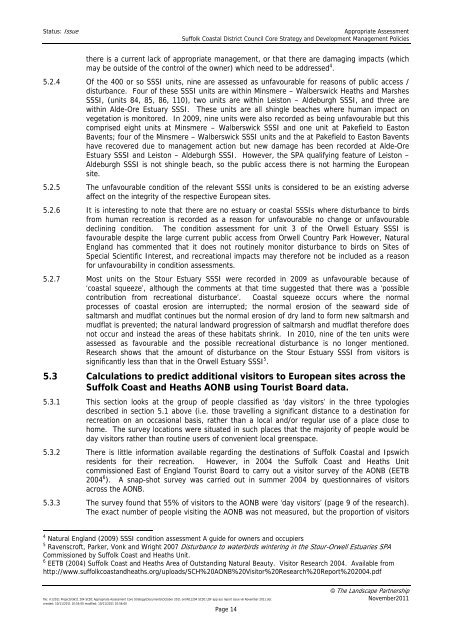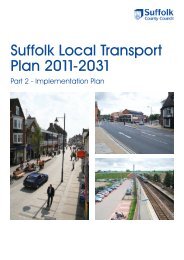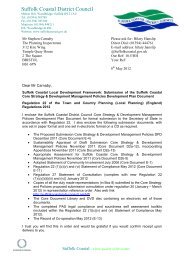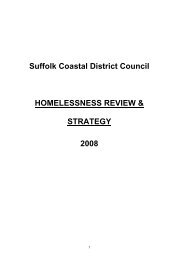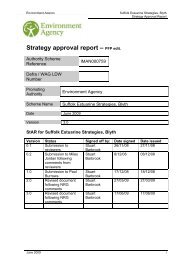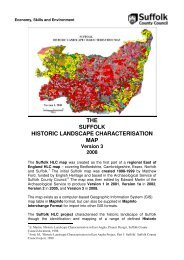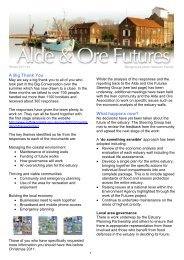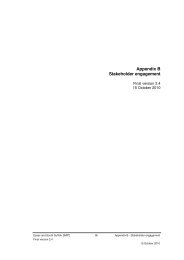natura 2000 standard data form - Suffolk Coastal District Council
natura 2000 standard data form - Suffolk Coastal District Council
natura 2000 standard data form - Suffolk Coastal District Council
Create successful ePaper yourself
Turn your PDF publications into a flip-book with our unique Google optimized e-Paper software.
Status: Issue Appropriate Assessment<br />
<strong>Suffolk</strong> <strong>Coastal</strong> <strong>District</strong> <strong>Council</strong> Core Strategy and Development Management Policies<br />
there is a current lack of appropriate management, or that there are damaging impacts (which<br />
may be outside of the control of the owner) which need to be addressed 4 .<br />
5.2.4 Of the 400 or so SSSI units, nine are assessed as unfavourable for reasons of public access /<br />
disturbance. Four of these SSSI units are within Minsmere – Walberswick Heaths and Marshes<br />
SSSI, (units 84, 85, 86, 110), two units are within Leiston – Aldeburgh SSSI, and three are<br />
within Alde-Ore Estuary SSSI. These units are all shingle beaches where human impact on<br />
vegetation is monitored. In 2009, nine units were also recorded as being unfavourable but this<br />
comprised eight units at Minsmere – Walberswick SSSI and one unit at Pakefield to Easton<br />
Bavents; four of the Minsmere – Walberswick SSSI units and the at Pakefield to Easton Bavents<br />
have recovered due to management action but new damage has been recorded at Alde-Ore<br />
Estuary SSSI and Leiston – Aldeburgh SSSI. However, the SPA qualifying feature of Leiston –<br />
Aldeburgh SSSI is not shingle beach, so the public access there is not harming the European<br />
site.<br />
5.2.5 The unfavourable condition of the relevant SSSI units is considered to be an existing adverse<br />
affect on the integrity of the respective European sites.<br />
5.2.6 It is interesting to note that there are no estuary or coastal SSSIs where disturbance to birds<br />
from human recreation is recorded as a reason for unfavourable no change or unfavourable<br />
declining condition. The condition assessment for unit 3 of the Orwell Estuary SSSI is<br />
favourable despite the large current public access from Orwell Country Park However, Natural<br />
England has commented that it does not routinely monitor disturbance to birds on Sites of<br />
Special Scientific Interest, and recreational impacts may therefore not be included as a reason<br />
for unfavourability in condition assessments.<br />
5.2.7 Most units on the Stour Estuary SSSI were recorded in 2009 as unfavourable because of<br />
‘coastal squeeze’, although the comments at that time suggested that there was a ‘possible<br />
contribution from recreational disturbance’. <strong>Coastal</strong> squeeze occurs where the normal<br />
processes of coastal erosion are interrupted; the normal erosion of the seaward side of<br />
saltmarsh and mudflat continues but the normal erosion of dry land to <strong>form</strong> new saltmarsh and<br />
mudflat is prevented; the <strong>natura</strong>l landward progression of saltmarsh and mudflat therefore does<br />
not occur and instead the areas of these habitats shrink. In 2010, nine of the ten units were<br />
assessed as favourable and the possible recreational disturbance is no longer mentioned.<br />
Research shows that the amount of disturbance on the Stour Estuary SSSI from visitors is<br />
significantly less than that in the Orwell Estuary SSSI 5 .<br />
5.3 Calculations to predict additional visitors to European sites across the<br />
<strong>Suffolk</strong> Coast and Heaths AONB using Tourist Board <strong>data</strong>.<br />
5.3.1 This section looks at the group of people classified as ‘day visitors’ in the three typologies<br />
described in section 5.1 above (i.e. those travelling a significant distance to a destination for<br />
recreation on an occasional basis, rather than a local and/or regular use of a place close to<br />
home. The survey locations were situated in such places that the majority of people would be<br />
day visitors rather than routine users of convenient local greenspace.<br />
5.3.2 There is little in<strong>form</strong>ation available regarding the destinations of <strong>Suffolk</strong> <strong>Coastal</strong> and Ipswich<br />
residents for their recreation. However, in 2004 the <strong>Suffolk</strong> Coast and Heaths Unit<br />
commissioned East of England Tourist Board to carry out a visitor survey of the AONB (EETB<br />
2004 6 ). A snap-shot survey was carried out in summer 2004 by questionnaires of visitors<br />
across the AONB.<br />
5.3.3 The survey found that 55% of visitors to the AONB were ‘day visitors’ (page 9 of the research).<br />
The exact number of people visiting the AONB was not measured, but the proportion of visitors<br />
4<br />
Natural England (2009) SSSI condition assessment A guide for owners and occupiers<br />
5<br />
Ravenscroft, Parker, Vonk and Wright 2007 Disturbance to waterbirds wintering in the Stour-Orwell Estuaries SPA<br />
Commissioned by <strong>Suffolk</strong> Coast and Heaths Unit.<br />
6<br />
EETB (2004) <strong>Suffolk</strong> Coast and Heaths Area of Outstanding Natural Beauty. Visitor Research 2004. Available from<br />
http://www.suffolkcoastandheaths.org/uploads/SCH%20AONB%20Visitor%20Research%20Report%202004.pdf<br />
© The Landscape Partnership<br />
file: V:\2011 Projects\W11 204 SCDC Appropriate Assessment Core Strategy\Documents\October 2011 on\W11204 SCDC LDF app ass report issue v6 November 2011.doc November2011<br />
created: 10/11/2011 10:55:00 modified: 10/11/2011 10:56:00<br />
Page 14


